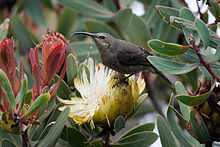Malachite sunbird
| Malachite sunbird | |
|---|---|
.jpg) | |
| A breeding-plumage male feeding on Leonotis flower nectar. | |
| Conservation status | |
| Scientific classification | |
| Kingdom: | Animalia |
| Phylum: | Chordata |
| Class: | Aves |
| Order: | Passeriformes |
| Family: | Nectariniidae |
| Genus: | Nectarinia |
| Species: | N. famosa |
| Binomial name | |
| Nectarinia famosa (Linnaeus, 1766) | |
The malachite sunbird (Nectarinia famosa) is a small nectivorous bird found from the highlands of Ethiopia southwards to South Africa.
Taxonomy
The sunbirds are a group of small Old World passerine birds, and are placed within the family Nectariniidae, which is found across Africa, the Middle East and into South-east Asia. Also called green sugarbird.
The malachite sunbird has two subspecies. The nominate N. f. famosa occurs mainly in South Africa, Lesotho and western Swaziland, although its range just extends into southern Namibia and Zimbabwe. N. f. cupreonitens breeds in the highlands from Ethiopia south to northern Mozambique.
Appearance
The breeding male malachite sunbird, which has very long central tail feathers, is 25 cm long, and the shorter-tailed female 15 cm. The adult male is metallic green when breeding, with blackish-green wings with small yellow pectoral patches. In non-breeding (eclipse) plumage, the male's upperparts are brown apart from the green wings and tail, the latter retaining the elongated feathers. The underparts in eclipse plumage are yellow, flecked with green.
The female has brown upperparts and dull yellow underparts with some indistinct streaking on the breast. Her tail is square-ended. The juvenile resembles the female.
Habitat
_2.jpg)

This large sunbird is found in hilly fynbos (including protea stands as well as areas with aloes) and cool montane and coastal scrub, up to 2,800m altitude in South Africa. It also occurs in parks and gardens (often nesting within those located in the Highveld). It is resident, but may move downhill in winter.
This species, like most sunbirds, feed mainly on nectar, although they will also take insects, especially when feeding young. This sunbird may hunt in a similar manner to a flycatcher, hawking for insect prey from a perch.
Most sunbird species can take nectar by hovering like a hummingbird, but usually perch to feed most of the time. As a fairly large sunbird, the malachite sunbird is no exception. They have long thin down-curved bills and brush-tipped tubular tongues, both adaptations to nectar feeding. Some plant species from which malachite sunbirds feed include many Aloe species, such as Aloe broomii, Aloe ferox and Aloe arborescens, and Protea species, such as Protea roupelliae as well as various other bird-pollinated plants such as Leonotis and Strelitzia.[2]
Breeding and behaviour
This species is monogamous.[3] The oval nest is usually suspended, as with most sunbirds, or built in a bush. The female incubates one to three dark-blotched greenish eggs for two weeks. The chicks are fed by both parents until fledging; they will continue to return to the nest to roost. The malachite sunbird is often double-brooded, but may be parasitised by Klaas's cuckoo or red-chested cuckoo. It is territorial and aggressive when nesting, but highly gregarious when not breeding, forming flocks of more than 1000 birds.
The call is a loud tseep-tseep, and the male malachite sunbird has a twittering song, often accompanied by pointing its head upward and displaying the yellow pectoral tufts with its wings half open. Males also have an elaborate display flight.
References
- ↑ BirdLife International (2012). "Nectarinia famosa". IUCN Red List of Threatened Species. Version 2013.2. International Union for Conservation of Nature. Retrieved 26 November 2013.
- ↑ http://www.biodiversityexplorer.org/birds/nectariniidae/nectarinia_famosa.htm
- ↑ http://www.biodiversityexplorer.org/birds/nectariniidae/nectarinia_famosa.htm
- Sinclair, Hockey and Tarboton, SASOL Birds of Southern Africa, ISBN 1-86872-721-1
External links
- Malachite sunbird - Species text in The Atlas of Southern African Birds.
